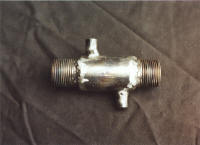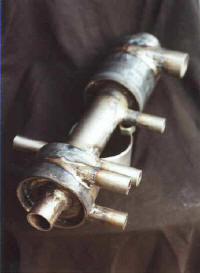Fuels
Some of the fuels we experimented with were:
- alcohols
- kerosene
- naphtha
- acetone
- toluene (xylene)
- fuel oil
- white gas (Coleman fuel)
- gasoline (motor fuel)
- soy oil
- mineral spirits
Besides testing these liquids as single component fuels,
we also blended various combinations to establish a baseline of characteristics.
For instance, the alcohols would not mix with the oil group -- including
naphtha, gasoline and mineral spirits. We even tried the gasoline additives
designed to remove water from your automobile fuel tank. Although the alcohol
and water mix, they in turn do not mix with gasoline -- which is why your car
doesn't always perform right.
Using the paint sprayer system, we tested all of the
single and multi-component fuels for ignition, burn and smoke characteristics.
Some preliminary results demonstrated that:
- Alcohol, acetone and toluene (xylene) would not ignite
under cold conditions using our spark arrangement.
- Kerosene, fuel oil, naphtha, gasoline, white gas, and
mineral spirits all ignited easily but burned with more or less
energy.
- Soy oil burned easily in combination with kerosene,
naphtha, mineral spirits, but also produced the most smoke.
Of all the components we tested, the overall winner was
mineral spirits. Even though mineral spirits is a multi-component fuel with
boiling points from 142 degrees C to 187 degrees C, it is more energetic than
gasoline (motor fuel) -- which is a blend of hydrocarbons with boiling points
from around 90 degrees F to about 435 degrees F. This witch's brew of white
gasoline and industrial waste is not only expensive to produce, unstable in
storage, mixed with 20% to 25% water during summer sales -- it is also part of
the political haggling process in Washington to complicate the country with over
40 unique blends of fuel.
What we have discovered is that all of the price haggling
and political intervention and control over motor fuel is really unnecessary. By
shifting the country to a simple distillate fuel like mineral spirits, we can
eliminate all the various blends of fuels -- which will result in lower prices
starting at the cracking plants. To utilize more of the fuels base, simple
blends of mineral spirits with kerosene and even soy (and other plant oils) will
move the country very quickly towards energy independence.
Now comes the tricky part.
Gasoline piston engines, as they are designed today, do not work
well with mineral spirits, fuel oil, or even pure alcohol. Petroleum distillates
detonate too easily in today's engines, resulting in rapid destruction of the
engine. Slowing down the burn to avoid detonation results in poor fuel economy
(as much as 40% of the fuel in your tank is simply blown out the exhaust port),
which is why catalytic converters are mandated -- to burn the wasted fuel.
This brings us to the next point. To utilize all of the
energy in fuel we have to pre-process the fuel into a near 100% burnable state.
Liquids do not burn -- only vapor or gas phase fuels burn! While carburetors and
fuel injectors work to convert liquid fuels to vapor state, the fuel still acts
as a quasi-liquid even in a hot cylinder.
 The only way we can achieve near-perfect combustion is to
start with a gas phase or gas state fuel. Photo C shows one of our primary stage
components for liquid-to-gas state devices. It's operation is really quite
simple; a close-fitting pipe is welded (gas-tight) around a smaller diameter
threaded pipe. An inlet and outlet are welded to the outer pipe. As heat from an
engine or combustor passes through the center (threaded) pipe, fuel is forced
through the outer cavity, transforming it to a vapor/gas phase (dependent on the
heat). The only way we can achieve near-perfect combustion is to
start with a gas phase or gas state fuel. Photo C shows one of our primary stage
components for liquid-to-gas state devices. It's operation is really quite
simple; a close-fitting pipe is welded (gas-tight) around a smaller diameter
threaded pipe. An inlet and outlet are welded to the outer pipe. As heat from an
engine or combustor passes through the center (threaded) pipe, fuel is forced
through the outer cavity, transforming it to a vapor/gas phase (dependent on the
heat).
 Photo D gives us a brief glimpse at a parallel development
project in an early construction stage. This fuel processor is designed to
convert any liquid-state hydrocarbon into a gas-phase fuel for use in any type
of engine -- gasoline piston, diesel piston, all types of rotary & turbine
engines, etc. Photo D gives us a brief glimpse at a parallel development
project in an early construction stage. This fuel processor is designed to
convert any liquid-state hydrocarbon into a gas-phase fuel for use in any type
of engine -- gasoline piston, diesel piston, all types of rotary & turbine
engines, etc.
Well, that's it for this month. Next month we will feature
a special test between a strict Tesla disk design versus a proprietary hybrid
design of our own, using thin section winglets mounted between the disks. We'll
also cover some of the inlet nozzle issues.
Anyone interested in learning more about our fuel
processor will want to link over to our PNGinc site. 'Til next time -- keep the
motive power revolution rolling!
Ken Rieli
^ Top of Page
|